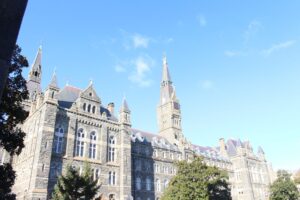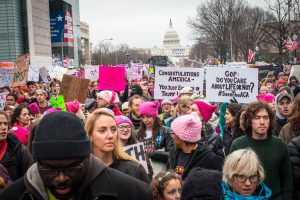Over 250 college-aged hackers descended on the Healey Family Student Center on Jan. 26th to participate in Georgetown’s third annual Hoya Hacks event. The event included a wide selection of lectures, tutorials, free food, and a chance to develop the tech world’s next hot idea – but the Hoya Hacks team was trying to be inclusive in a different sense. This year, organizers aspired to see more diversity in their attendees, though opinions of the definition of the word “diverse” were themselves varied.
Eytan Gittler (NHS ’18), a Hoya Hacks co-director, will tell you diversity extends deeper than conventional categories of race, gender, and class. For Gittler, diversity is about building academic bridges, both between universities and within them, to gather a more diverse set of interests around the tools which tech provides.
“We’re really getting more of the Georgetown community invested in the idea of the hackathon, really connecting it to as many of the departments, schools, clubs as possible because this is the opportunity for anyone from every single background … to come together and to do something good,” Gittler said.
Gittler believes strongly in the mission and values of hackathons like Hoya Hacks. He said they break down stereotypes and open doors, proving the value of tech innovation and cooperation. Hackathons involve a long, often sleepless competition (36 hours at Hoya Hacks) in which groups of tech-savvy students try to design a creative, tech-based idea in a certain field. This year Hoya Hacks’ competition tracks included health care, education, gender equality, and a few others. Gittler mentioned that the Gender Equality track started last year.
Gittler said he was pleased with the event’s attendance and its diversity, noting the number of universities which had sent students.
“I think if you look outside you’ll see a pretty diverse group of people, people from all different backgrounds. I think we have people from at least 30 different schools,” Gittler said.
He did not explicitly include women or people of color in his praise of the event’s diversity. He did mention, however, that he believes women and racial minorities are underrepresented demographics within the tech world and noted that Hoya Hacks was actually founded by two female students in 2016.
It’s easy to see why Gittler might have avoided the idea of gender when he discussed this year’s turnout. It was clear that there just weren’t that many women there, and though many of the staff, lecturers, and instructors were women, there were few in attendance.
One female organizer, Aleida Olvera (COL ’20), said she wasn’t pleased with the event’s turnout, though she was hopeful about the future.
“I will be honest, Hoya Hacks didn’t really fully accomplish their goal of making sure they had enough women,” said Olvera. “I think it might have been like 15% of the attendees were women, and honestly that’s a big disappointment.” She described hackathons as “bro-contests.”
Though Olvera’s lectured on software for making apps as an experienced female techie, her entire audience was male. One participant asked Gittler who the “guy” was who had given the lecture, because he had missed it and wanted to ask a few questions. The assumed “guy” was Olvera.
“Being one of the organizers, my main goal was to make sure that we had a womanly presence throughout the entire hackathon,” said Olvera.
Olvera also pointed out a lack of racial diversity at the event.
“I saw very few people of color in attendance,” she said.
Olvera identifies as Mexican-American. According to Business Insider, Latinos accounted for an average 6.3% of employees in Silicon Valley’s 23 largest firms in 2017, though they make up 12 percent of the US population. The number for black employees is similar, and they too make up about 12 percent of the national population.
Additionally, while Hoya Hacks participants did include a large number of non-white students this year, most of those non-white students were Asian, a racial demographic which, in the same study, accounted for an average 29.3% of Silicon Valley employees, despite making up only 4 percent of the national population.
Gittler explained how the efforts to entice more racially diverse teams to participate had materialized in this year’s marketing campaign.
“It’s not necessarily doing anything differently other than just being louder, and making sure we actually reach out to more people,” Gittler said.
He then detailed the number of universities and other hackathons which Hoya Hacks had contacted over the year, but it there didn’t seem to have been an initiative to explicitly attract women, Hispanics, and African-Americans. For Olvera, such initiatives lie central to the event’s success.
“Next year it’s going to be a main focus to bring in more people of color,” Olvera said.
Hoya Hacks has completed its third year and its future is open to more development. So far its team has achieved considerable growth in attendance and made efforts to gather minds from all walks of life. Altogether, Olvera was proud of the event.
“I think Hoya Hacks went really well this year,” she said.
The organizers agree on the common goal of making the event more meaningful and available to everyone. Ultimately, Gittler and Olvera believe that Hoya Hacks is on track to become a significant and inclusive component of the Georgetown community and perhaps the tech community as a whole.





